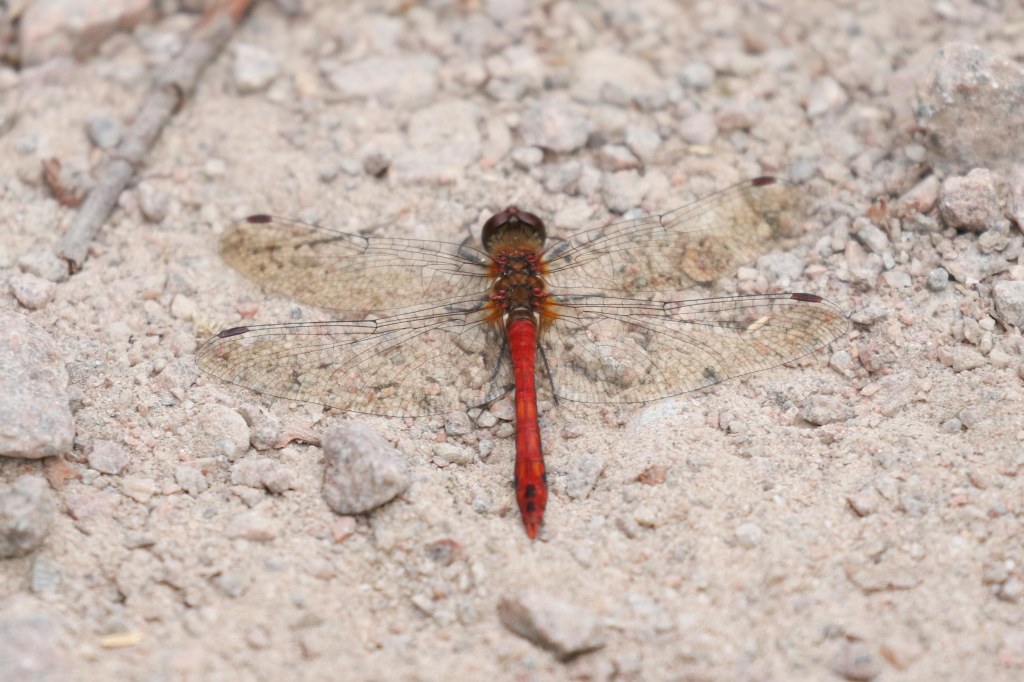Another Private Tour today in North Norfolk. This time, a specific request to go and look round Snettisham Coastal Park and Ken Hill Marshes. It was cloudy and threatened to spit with rain a couple of times, but stayed dry. It was also warmer than of late, with slightly less blustery NE winds, which meant it was difficult to work out how many layers to wear at times!
As we drove across to Snettisham this morning, a Red Kite drifted over the road. There were lots of Linnets on the wires as we drove past Ken Hill Estate down along Beach Road, immediate beneficiaries of the regenerative agriculture in the field here which was previously used for intensive arable crops.
We parked by the seawall and walked up to the entrance into the Coastal Park. A Chiffchaff was calling in the sallows. As we got to the gates, we looked up to see a Turtle Dove on the wires. We had a good view of it in the scope, though it was looking a bit tatty.
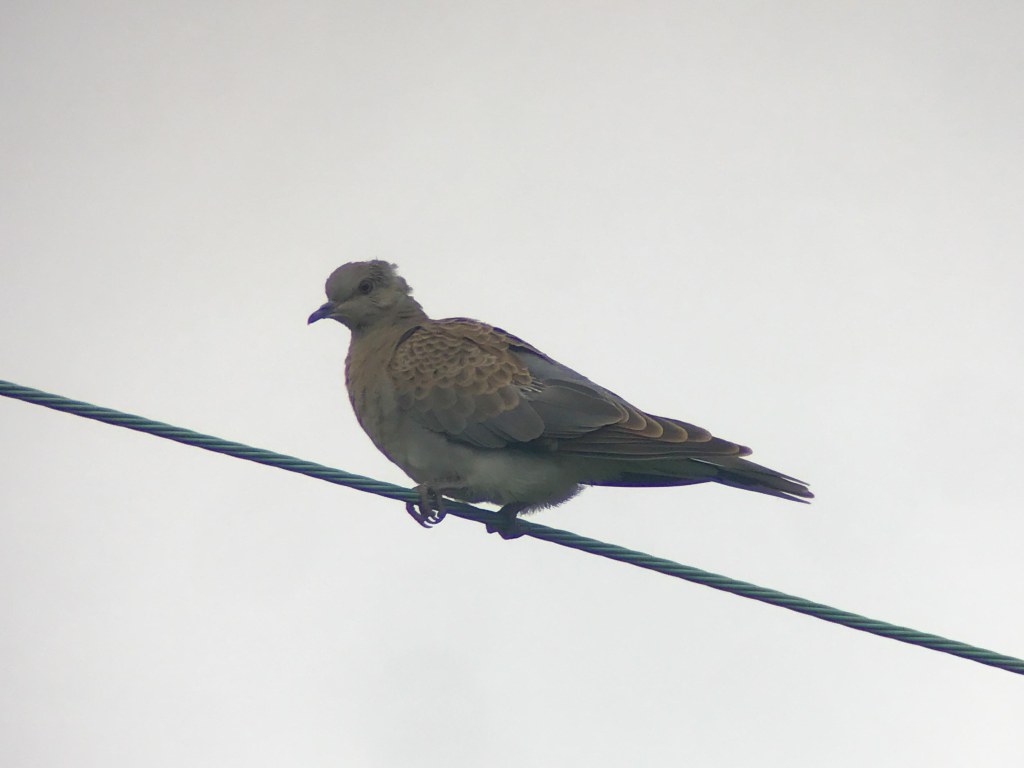
When the Turtle Dove flew down, we continued on into the bushes. There was a hive of activity around the first small open grassy area – several Common Whitethroats in the hawthorns, a couple of Blackcap calling, a Chiffchaff flycatching from the top of a small briar patch, plus tits, Robins, Dunnocks, Starlings and Blackbirds. We stopped to look through them.
There were lots of House Martins and Swallows hawking overhead, gathering ahead of the long journey to Africa for the winter. A lone Common Swift appeared too – most have already left us, but there have been a few late birds along the coast this week. Sad to think that already this may be the last one we will see this year.
Continuing on, the bushes further up were a little quieter. We heard a Lesser Whitethroat tsking from the bushes, but it went quiet before we could start to work out where it was hiding. There were lots of Goldfinches around the outer seawall, including a good number of plain-faced juveniles.
When we got up to the crossbank, we climbed up onto the seawall to have a look out over the Wash. The tide was out, but we could see lots of waders along the distant shore. We got the scope on them – Curlews, Bar-tailed Godwits, Redshank, lots of Knot and several Grey Plovers, some still sporting their summer black faces and bellies.
As we turned round to scan over the grassy area north of the crossbank, we spotted another Turtle Dove flying towards us, from the direction of Heacham. We watched as it continued on past, before we lost sight of it flying through the bushes down through the Coastal Park. A Common Buzzard circled up inland and a couple of Kestrels were hovering out over the marshes.
Across from the inner seawall, the pools out on Ken Hill Marshes have dried up a lot over the last couple of weeks. There was still a bit more water on the marshes to the north, so we walked up for a closer look. There were lots of geese on here, mostly Greylags including several feral white ones and various in-betweeners. A group of Egyptian Geese were with them, mostly asleep. We found two Barnacle Geese too – presumably part of the ever growing UK feral population.
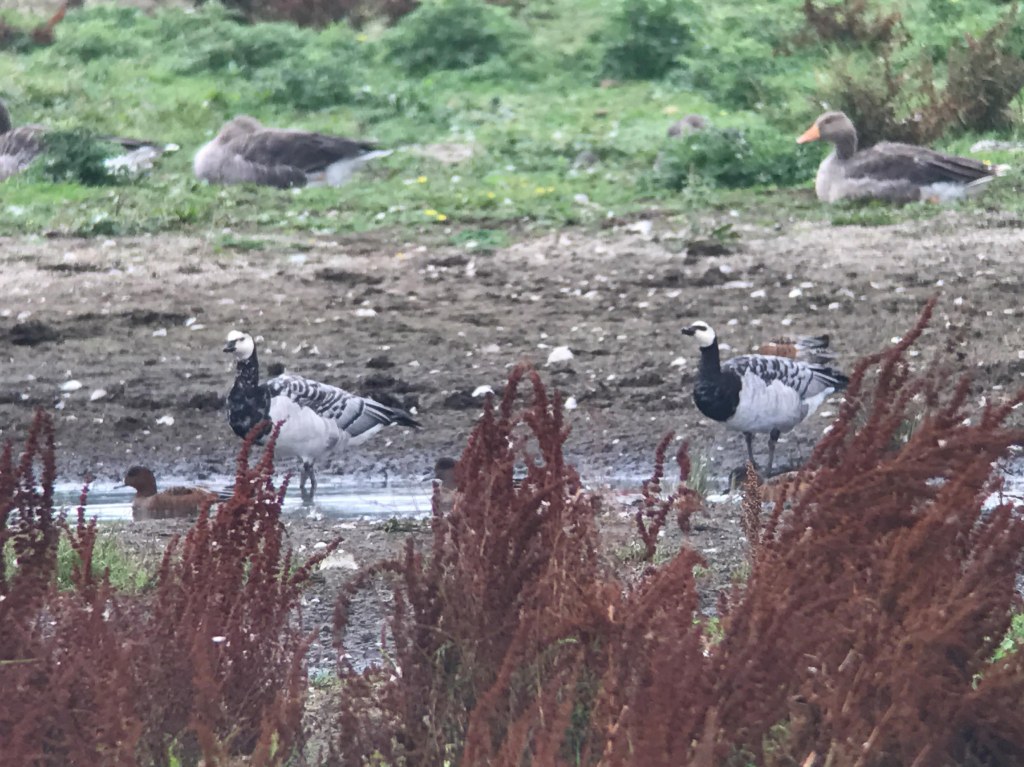
There were a few ducks too, including a few Wigeon, birds already returned for the winter. We heard a couple of Green Sandpipers calling and picked one up flying up from the pools. Two Marsh Harriers circled over the back of the marshes. A couple of Grey Herons were lurking in the overgrown vegetation.
We heard Stonechats calling distantly behind us, but couldn’t find them initially. We eventually located them right over the far side of the grazing marshes. Even better, the first bird we got the scope on was a Whinchat – we could see its obvious pale supercilium, paler buff-brown upperparts and paler peachy-orange underneath. The birds were perching up on the tall ragwort seedheads and bramble clumps beyond and dropping down to look for food in the short grass, out of view. After watching them for a while, we had counted at least two Whinchats and five Stonechats.
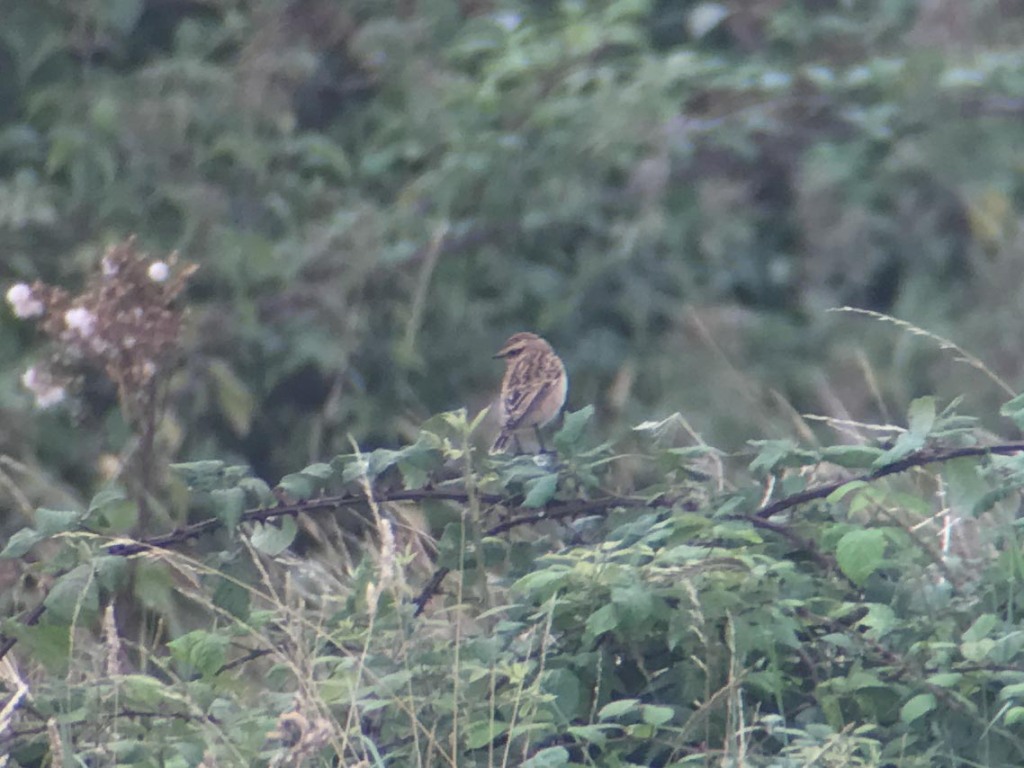
Walking back south along the inner seawall, the pools out on Ken Hill Marshes were too overgrown now to see much, although we did find a Little Grebe with the geese and ducks on one of the more open areas of deeper water. There were still various warblers calling from the bushes, including a Cetti’s Warbler down by the ditch below the bank which remained typically elusive.
What was presumably the same Common Swift was still hawking over the Coastal Park and the Marshes – it seemed to keep passing us going north, but presumably was the same bird doubling back each time.
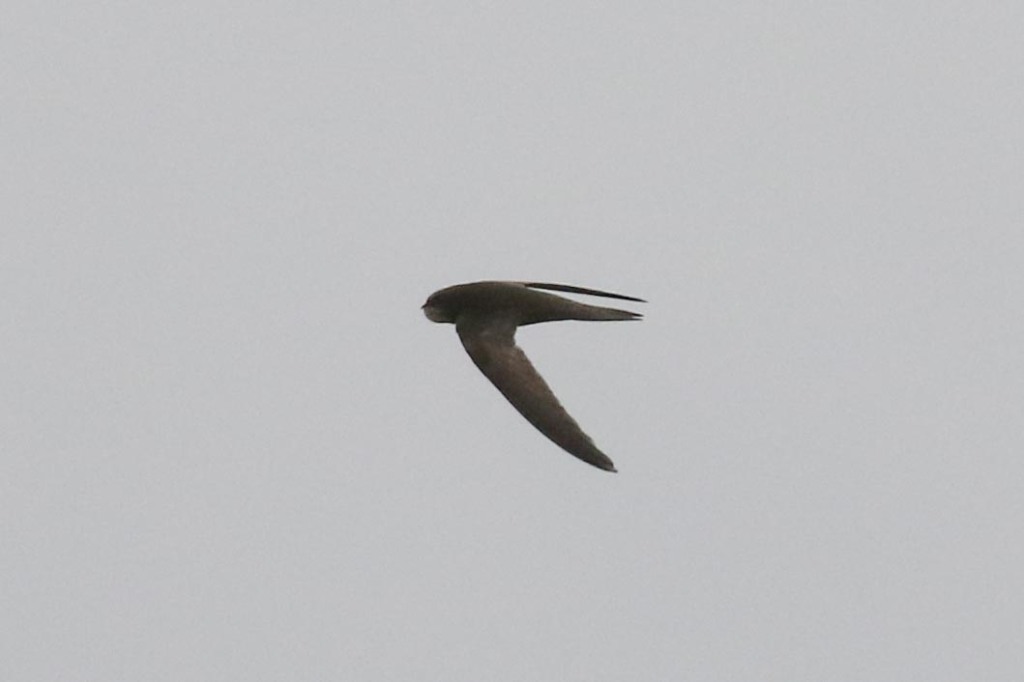
We cut back in through the south end of the Coastal Park, but it was a lot quieter now than it had been earlier. It was already well after midday by the time we got back to the minibus, so we had a quick discussion about what we would like to do for the rest of the afternoon. The decided target was Pied Flycatcher and any other migrants. We thought about going to Holme Dunes, but the new NWT parking booking system which has been in place for the summer precludes and hint of spontaneity in visiting there any more (you have to book in advance!), so we went to Wells Woods instead.
When we got to Wells, we stopped for a late lunch in the car park. It had brightened up quite a bit now and was quite pleasant out of the breeze, sheltered by the trees. After lunch, we set off into the Woods. The boating lake had a few Little Grebes on it but not much else of note today.
Walking in through the birches, it was rather quiet at first, but before we got to the edge of the Dell we came across a flock of birds feeding in the trees. At first, all we could see were tits, Coal, Blue and Great Tits, and several Treecreepers which spent some time feeding in one of the big pines and a neighbouring hawthorn.
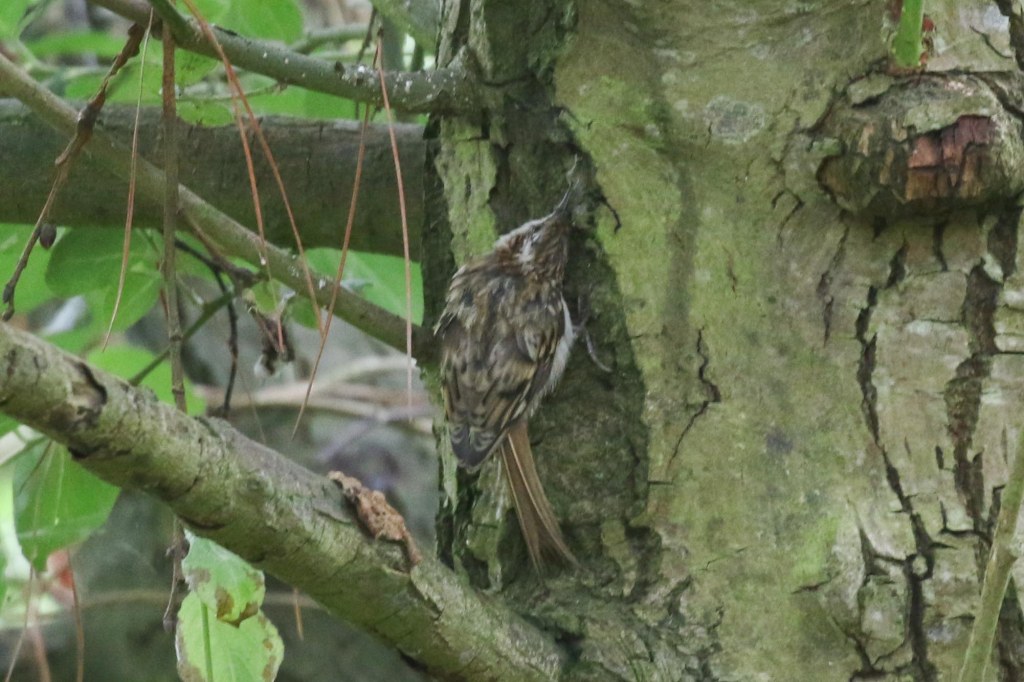
We could hear a Pied Flycatcher calling so we walked a little further and found it flitting around high in the birches. A second Pied Flycatcher flew across in front of us into the sallows nearby, on the edge of the Dell. They were very active, moving all the time, and hard to see in the leaves most of the time, but a couple of times they landed in full view for a second or two.
It was hard to tell at first which way the flock was going, but eventually the tits moved off south towards the main path, so we tried to keep up with them. There were a few warblers with the flock too, several Chiffchaffs and we had good views of a lovely lemon-yellow Willow Warbler feeding high in one of the birches.
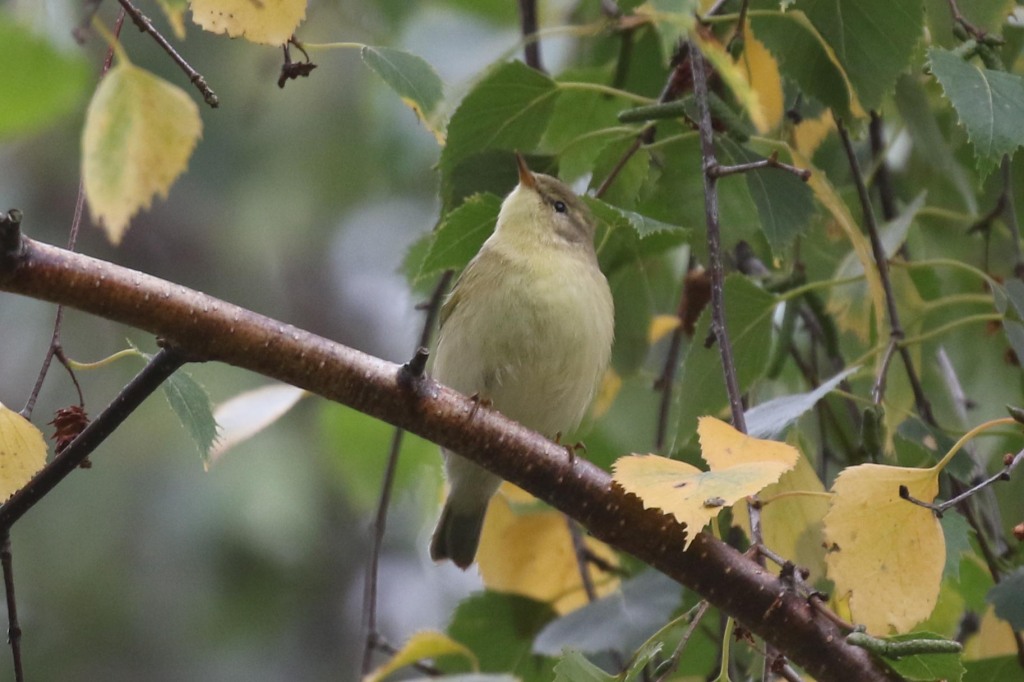
The tits moved on again and we set off after them. As we did, a Pied Flycatcher started calling from low in the trees beside us and we turned to see it land. It remained on the same perch for a couple of minutes, giving us great views this time.

When the Pied Flycatcher eventually flitted up into the trees, we set off in the direction the flock had disappeared. But we couldn’t find it now – it had probably continued on over the main track and into the caravan park. We had a quick walk around the open area south of the track, but it was very quiet today and there were just a few Woodpigeons out on Quarles Marsh.
We cut back in to the Dell meadow and then back round the west and north sides of the Dell, but apart from one or two Chiffchaffs and Jays calling it was rather quiet. As is usually the case here, it is all or nothing – most of the birds tend to be with the flocks. There were good numbers of Speckled Wood butterflies still on the wing, though some are looking rather tatty. We watched a male Specked Wood displaying to a very tatty female.
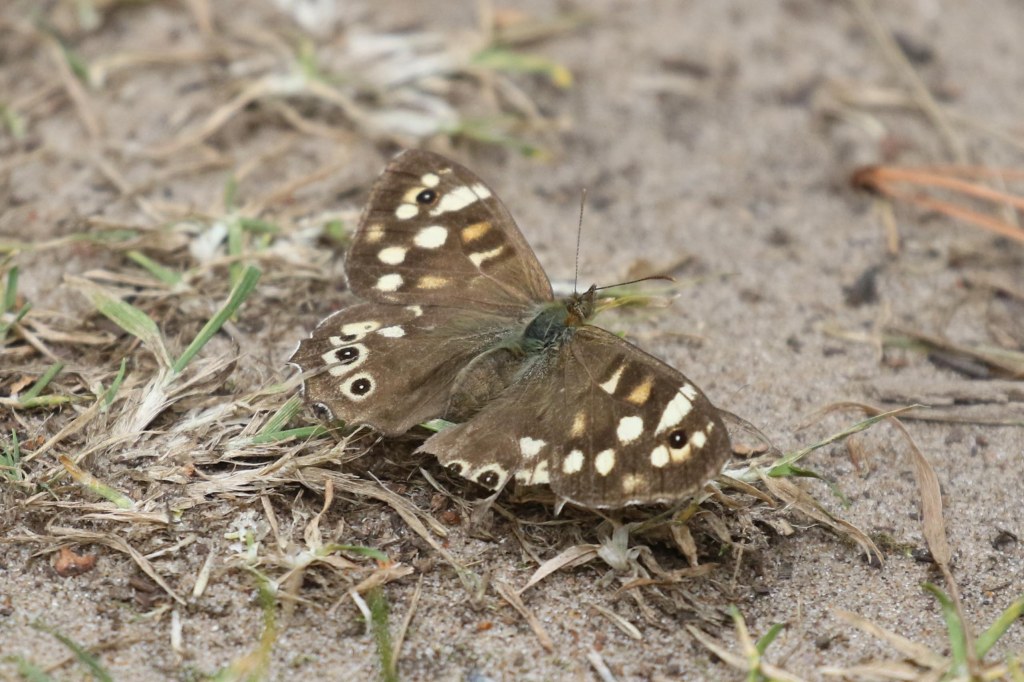
There were quite a few dragonflies out now too – several Migrant Hawkers and a nice apple-green Southern Hawker in the trees. On the north side of the Dell, several dead flower stems in the grass were each adorned with a basking Common Darter on the top.
There were several people now watching one of the Pied Flycatchers on the east side of the Dell as we cut back out to the main track again. We had to be back in good time this afternoon, so we didn’t have enough time now to do anything else. We decided to walk on along the track down to the drinking pool.
The birches by the main path were quiet. As we cut in towards the drinking pool, something flew up from the ground under the trees – a large female Sparrowhawk, it landed briefly in the tops before flying off through the pines. Even though there is still a small amount of water in the bottom of the pool, there was no sign of anything coming in to drink or bathe this afternoon.
Back out on the main track, it was time to head back. A smart male Ruddy Darter basking on the path was a nice late addition to the day’s dragonfly list.
